How to plant and care for Jasmine to make it blossom
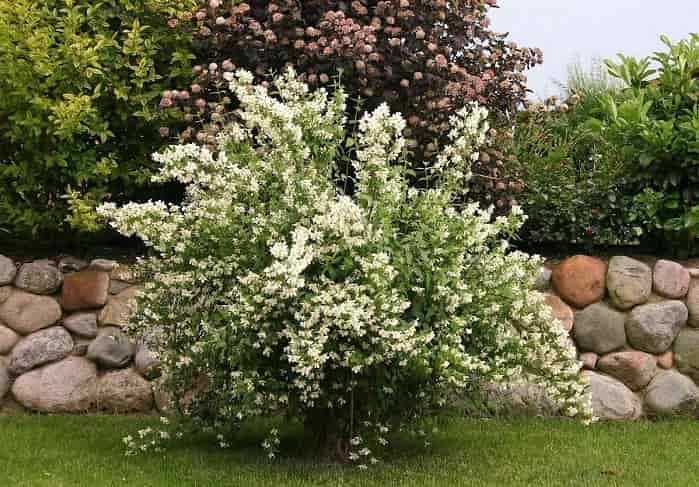
Contents:
- Description of the plant
- Types and varieties of jasmine
- Planting and care recommendations
- Fertilizing options
- Reproduction methods
- Trimming the shrubs
- How to transplant Jasmine correctly
- Prepare plants for winter
- Potential growth problems
- Pests and diseases
- What can be planted next to Jasmine?
Garden jasmine (or mock-orange) has long been famous for its medicinal properties, but it is more often grown as garden decoration. For better aesthetics, it is planted next to blue and purple flowers — lavender, delphinium, spirea, and hydrangea. One of the advantages of this shrub is the ability to adapt to weather conditions. Garden jasmine can grow both in partial shade and in the sun, unpretentious and undemanding to care. It tolerates high humidity and drought well. Below we will tell you how to grow jasmine on your site, and you will see that this requires very little effort.
Description of the plant
The jasmine bush is distinguished by its lush crown, strewn with white and yellow inflorescences, and a fragrant aroma. During flowering, essential oils are released into the air, thanks to which the plant smells so pleasant. Bees and other insects willingly collect nectar from its inflorescences.
Types and varieties of jasmine
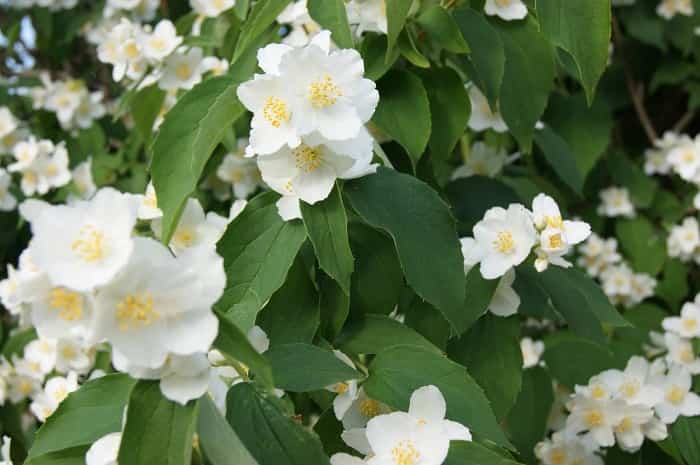
There are a wide variety of subspecies of garden jasmine, differing in the size of their flowers. The most popular of them are the following varieties:
- Small-leaved. Height — up to 1 m (59 in). Leaves are curved and large. The aroma is reminiscent of strawberries.
- Common. Height — up to 2.5—3 m (98—118 in). Blooms with large inflorescences with a pleasant smell. Leaves are richly golden.
- Fluffy. A good choice for a park or a spacious area. Height – up to 4 m (157 in). Flowers do not smell, but look beautiful for about 4 weeks.
- Ermine mantle. Height — up to 1 m (39 in). Flowering lasts 8 weeks. Inflorescences grow evenly along the entire branch.
The specifics of growing garden jasmine often depend on the type of plant. Thus, growing and caring for liana jasmine outdoors will be slightly different from growing shrubs, but the general rules of care are the same.
Planting and care recommendations
How to grow a strong and healthy jasmine tree? First, you need to choose the right time and place for planting. Agricultural experts advise planting garden jasmine in early spring and give the following recommendations:
- It is advisable to choose a site without drafts with sufficient lighting. The more light, the more spectacular the bush looks.
- Jasmine roots do not like over—watering, so it is better to plant it on a slight elevation.
- If you plan to create a hedge, plant the plants at a distance of 50 cm (20 in) from each other. They cannot be planted closer, since the bush has an extensive root system.
- The depth of the planting hole should be no more than 80 cm (31 in), the diameter — about 50 cm (20 in), so that the roots do not become deformed.
- The hole prepared for planting should be left for several days to warm up in the sun’s rays.
- Then fill the hole with a mixture of stones and sand as a drainage layer and add 50 g (1.8 oz) of nitrophosphate to improve the survival rate of the bush.
- Prepare a soil mixture of peat and black soil with the addition of ash, sand and humus. Fill it into the hole, forming a mound.
- Place the seedling on the mound, spreading the roots. It is important to deepen the sprout, but avoid immersing the root collar in the soil more than 3 cm (1.2 in). Add soil and compact the hole.
- Moisten the soil with 2 buckets of water.
- Mulch the soil with sawdust, peat or pine needles.
Fertilizing options
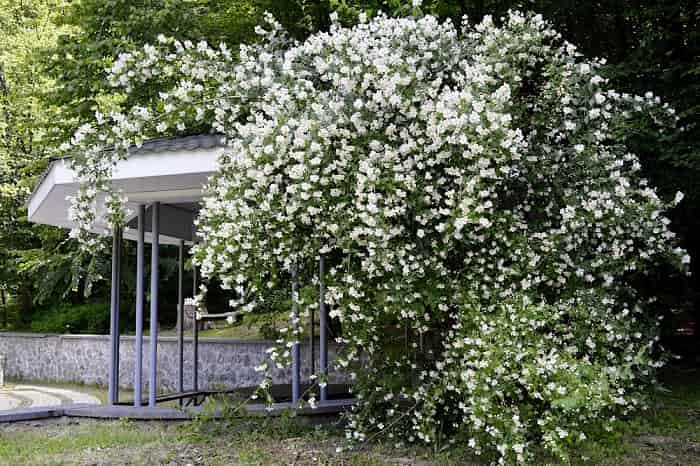
Growing jasmine in the garden involves the use of fertilizers. The first feeding is carried out a year after planting in the ground.
Of the mineral fertilizers, the most suitable for jasmine will be a solution of 1 liter (0.3 gals) of water and 5 g (0.2 oz) of superphosphate, 2.5 g (0.1 oz) of potassium sulfide, and urea. If you prefer organic fertilizers, humus and manure can be used. Manure can be used only in diluted form, otherwise you can burn the roots. The proportion for preparing liquid manure is 1:15.
Reproduction methods
If you want to grow a hedge from a single ornamental shrub planted on the site, you first need to choose a method of plant propagation. Possible options:
- By seeds — into open ground or a box with subsequent transplantation.
- By cuttings: take cuttings in early June and plant them in a greenhouse or in open ground.
- By shoots: in the fall, separate strong and sturdy shoots from the mother plant, and in the spring, after wintering indoors or in a greenhouse, plant them in the area.
- By dividing the bush: in the fall, dig up the plant and very carefully divide the root system into several parts so that each part has at least 2—3 stems.
Trimming the shrubs
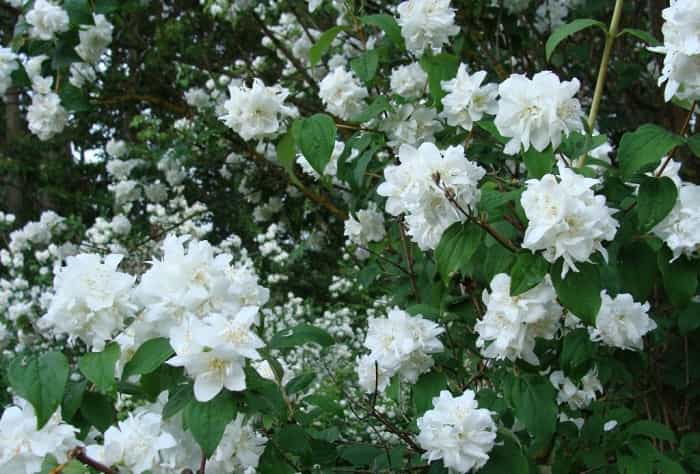
Answering the question of how to grow garden jasmine, one cannot help but mention another procedure — timely pruning of the bush. It is important to inspect the bush annually, remove diseased and damaged branches, form the desired height of the plant and the splendor of the crown.
What experienced gardeners who know how to grow beautiful garden jasmine recommend:
- carry out pruning only in spring, while the plant is in a vegetative state;
- the longest shoots should be removed completely, and the medium ones should be shortened by half;
- to increase the number of inflorescences, trim empty branches;
- Do not allow the central stem of an adult plant to grow taller than 50 cm (20 in).
How to transplant Jasmine correctly
For a number of reasons, in the process of care and cultivation in the garden, it may be necessary to transplant jasmine to another place, and it is important to know how to do it correctly so as not to harm the plant. Adult bushes are transplanted if they receive little sun, being in the shade of nearby trees, and therefore develop poorly and bloom little. Also, garden jasmine is transplanted for landscape design purposes.
Plan to replant ornamental shrubs in spring or autumn. In the latter case, early October is suitable. By this time, the bush will have time to get stronger and recover after flowering. Gardeners do not recommend replanting plants older than 7 years. Otherwise, there are no restrictions.
Stages of transplantation:
- Dig a spacious hole and pour drainage into the bottom.
- Mix the soil with fertilizers (superphosphate, humus, wood ash).
- Pour a bucket of water into the hole and wait 30 minutes.
- Thin out the ornamental shrub as needed, removing old shoots.
- For convenience during transplantation, carefully tie the remaining branches with rope.
- Moisten the soil thoroughly the day before transplanting.
- Carefully dig out the roots, being careful not to damage them.
- Move the ornamental shrub to the prepared hole in the new location and fill it with soil and water.
- Mulch the ground with pine needles or bark.
After this, all that remains is to monitor how the plant develops. If all stages are performed correctly, the garden jasmine will quickly adapt to the new location and begin to grow.
Prepare plants for winter
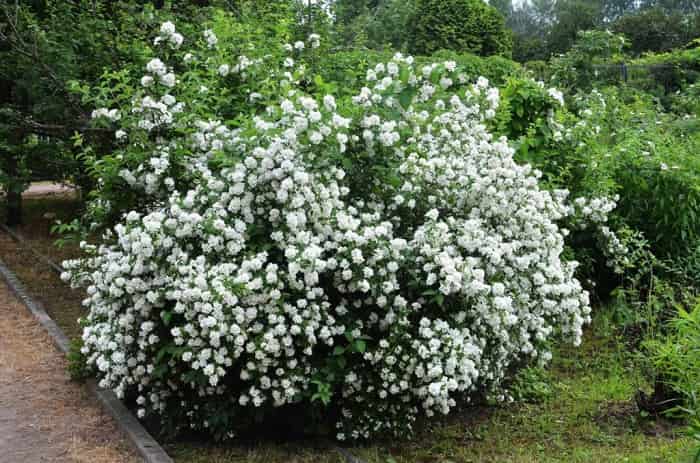
In the list of works on creating suitable conditions for growing garden jasmine, preparation for wintering is a mandatory item. The goal is to help the bush survive frosts.
An adult jasmine bush is more frost-resistant than young plants, so it does not need to be prepared for winter, paying attention only to the young plants. After the flowering period, the trunk circle is covered with straw or other material that can insulate the roots. Also, to protect the root system in the fall, the bush is dug up and compost is added to the trunk circle.
As you can see, it is not difficult to grow a decorative bush with beautiful flowers. You just need to take into account its needs and follow the rules of planting and care. Before you buy a plant, learn more about how experienced gardeners grow jasmine in their gardens: what fertilizers they use and when they use them to achieve abundant flowering.
Potential growth problems
Jasmine is a shrub from the Oleaceae family. It is a heat-loving plant that is difficult to grow in regions with a cold climate. Of the 200 species of the plant, only a few are suitable for the conditions of the middle zone, and they require shelter in severe frosts. In summer, the heat-loving plant should receive 5 hours of diffused sunlight. Garden jasmine grows poorly in the shade and practically does not bloom. It is best to plant it on the southern side of the garden near a fence that protects it from the cold wind.
The most common problem when growing jasmine is the foliage, which dries out, curls up, and becomes deformed. The leaves begin to fall off. This happens due to dry air, insufficient watering, and prolonged exposure to direct sunlight.
If the buds on the plant do not open, this means there is not enough light. If the flowers darken, transplant the bush to a more shaded and cool place and water the jasmine more abundantly.
To improve the growth of the bush, it is recommended to prune it in early spring, after which additional side branches will form. Fragrant buds should soon appear and bloom on them. Shoots should be cut by 40—60% of their length. Completely remove dry and damaged branches. From spring to autumn, pinch new shoots monthly.
If the plant blooms poorly or does not bloom at all, the reason may be the presence of lime or nitrogen in the soil. You should feed the bush with nutrient mixtures containing potassium and phosphorus or transplant the plant into another soil.
If the jasmine bush has stopped blooming and is affected by a fungal disease, check if there is stagnant water in the root zone. To do this, you need to dig up some of the soil and, if so, dig up the ornamental bush and put drainage under it, and then plant the garden jasmine in place.
If a bush quickly fades and does not bloom abundantly, the reason may be the close location of the bushes or old age.
Pests and diseases
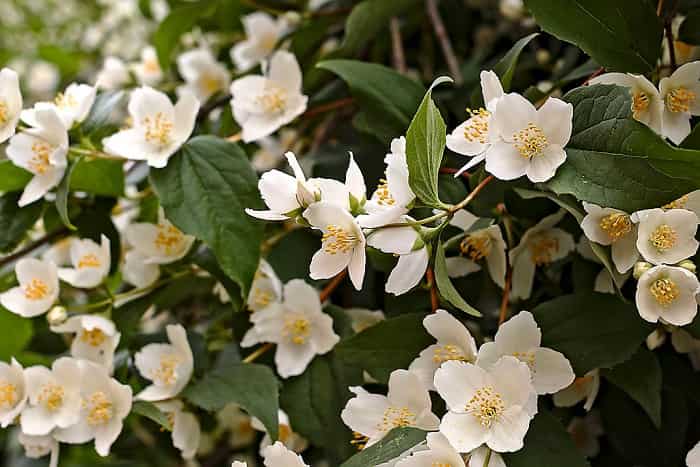
The most common pests that attack the plant are mealybugs, leaf weevils, scale insects, aphids, and whiteflies (spider mites). You can see what they look like in the photo on the Internet. Appropriate chemicals should be used against them. If pests are not detected in time, the plant may die.
Regularly inspect the ornamental bush from all sides: you will find aphids on the tops of shoots, spider mites — between the leaves of jasmine or on their back in the form of small dots and cobwebs. Weevils feed on the juice of leaves and are similar to caterpillars, living in the soil.
First aid when pests are found is to wash the bush with a copious stream of water from a hose. This will wash away some of the parasites. You can try to destroy the insects with a tobacco infusion: 250 g (8.8 oz) of tobacco leaves +50°C (122°F) g of laundry soap per 3 liters of water. If this does not help, use the chemicals “Agravertin”, “Intavir”, “Aktellik”.
What can be planted next to Jasmine?
It is not difficult to grow jasmine with proper care. The bush grows quickly, so it is not recommended to plant perennials near it: it will shade them. Of the annuals, you can plant whatever you like.
If planted correctly, many plants feel good next to jasmine. Depending on the variety and crown shape, you can plant low-growing crops around the bush: cinquefoil, clethra alder—leaved, rockrose.
Tree-like bushes up to 3—4 m (118—157 in) in height will look good, framed by calycanthus, herbaceous peonies, lilies, hydrangeas, and also spherical plants. Dwarf bushes up to 1 meter (39 in) in height get along well with zamaniha, lespedeza, hibiscus, and quince.




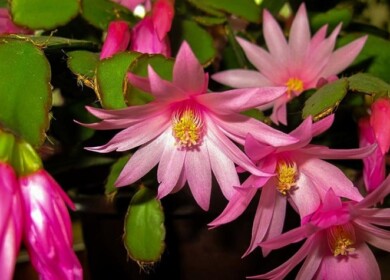
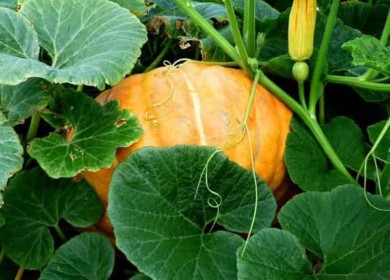

Discussion0 comments